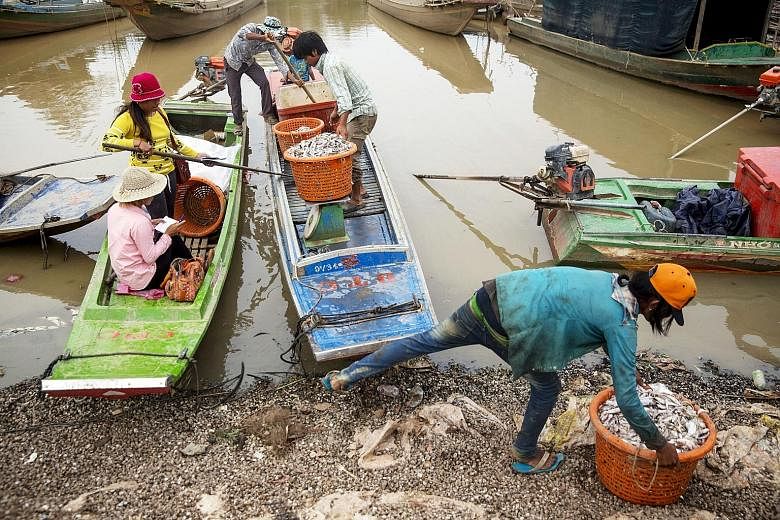Every year during the wet season, millions of Cambodians are surrounded by water as the Mekong River floods. Yet the water is unsafe to drink, fouled by sewage and agricultural and industrial pollution.
Living in villages on stilts, Cambodians bathe, fish and defecate in the flooded Tonle Sap, South-east Asia's largest freshwater lake. Storage of clean water is difficult and traditional forms of sanitation, such as pit toilets, are not possible. This leaves children especially vulnerable to water-borne diseases.
According to Unicef, about 6.3 million Cambodians, or about 40 per cent of the population, lack access to safe water. Their plight mirrors a broader global crisis in which one in nine people does not have access to clean water and one in three lacks improved sanitation. Many live in the developing economies of Asia and sub-Saharan Africa.
-
4 in 10
Cambodians lack access to clean water.
400%
Projected percentage growth in global water demand for manufacturing between 2000 and 2050.
300k
Number of people in Cambodia and southern Vietnam who benefit from Lien Aid's community water enterprises.
-
Protecting earth's precious resource
-
SCARCE
Only 2.5 per cent of the water on earth is fresh. And of that, just 1 per cent is easily accessible, with much of the rest trapped in ice caps and glaciers. That means only 0.007 per cent of the planet's water is available to its more than seven billion people.
RAPID GROWTH
Water use has been growing at more than twice the rate of population increase in the past century, according to the United Nations. By 2025, about 1.8 billion people will be living in countries or regions with absolute water scarcity.
HEALTH RISK
About 3.5 million people die each year because of inadequate water supply, sanitation and hygiene, according to Unesco.
OVER USE AND POLLUTION
Over-extraction from wells, inefficient use in agriculture, poor infrastructure and pollution have greatly reduced the availability of clean water. Industries dump an estimated 300 million to 400 million tonnes of polluted waste in water bodies every year, according to the UN.
Half of China's top 10 river systems are polluted, and about 60 per cent of the nation's underground water is of poor quality, a 2013 Chinese government report said.
WHAT HAS BEEN DONE?
Between 1990 and 2010, 2.3 billion people gained access to improved drinking water sources, such as piped supplies and protected wells, according to the United Nations World Water Development Report 2015.
Yet, about 750 million people do not have access to clean water supplies and that number is set to rise.
China last year announced an action plan to improve water quality in seven major river valleys and coastal areas so that 70 per cent will be "good" by 2020 and over 75 per cent "clear" by 2030.
-
David Fogarty
-
Brought to you by

While governments and non-governmental organisations have worked hard to bring clean water to millions of people, demand for water is spiralling. Rapid population growth is fuelling more demand for food and goods, meaning agriculture and industry are using ever greater amounts of water.
In Asia, about 70 per cent of water is used for agriculture, particularly for thirsty crops such as rice.
"By 2050, agriculture will need to produce 60 per cent more food globally, and 100 per cent more in developing countries," says the United Nations World Water Development Report 2015.
Water demand for manufacturing is expected to increase by 400 per cent between 2000 and 2050 globally, it adds. Climate change is another growing risk, triggering worse droughts, floods, storms and rising sea levels.
The issue of water scarcity is complex. In some areas, there is abundant water but the water is polluted by agricultural run-off, such as fertilisers, or by industry. In others, the water is wasted by inefficient crop-growing practices.
Some areas such as the Middle East, northern India and northern China around Beijing are water stressed because of large populations living in arid regions - water demand far exceeds supply.
According to the US National Aeronautics and Space Administration (Nasa), 21 of the world's 37 largest aquifers have passed the sustainable tipping point. What this means is that water levels have plunged and cannot recover fast enough.
The aquifers include those that Beijing and its surrounding areas rely on as well as those in the Ganges Brahmaputra Basin in northern India.
Vietnam's Mekong Delta, another major rice-growing region, is facing falling water levels because of dams built on the Mekong upstream by China and on tributaries in Laos, Vietnam and elsewhere. Salt water intrusion caused by rising sea levels is further threatening water supplies and livelihoods.
There are solutions, but they require investment, better policies and better enforcement.
China has spent about US$80 billion (S$111.5 billion) on a controversial aqueduct system that ships water from the south to the parched north. Some farmers are switching to less thirsty crops and using water-efficient practices, while China and other governments are cracking down on polluting industries.
Water-recycling and desalination, as used in Singapore, are also effective.
For poor Cambodians, simpler solutions have proven successful.
Lien Aid, a Singapore-based international non-profit organisation, has installed more than 50 community water enterprises in Cambodia and southern Vietnam, benefiting more than 300,000 people. Lien Aid builds water treatment and bottling plants within communities which are subsequently owned, operated and maintained by the communities upon completion.
Such simple systems can have a dramatic impact by cutting illness, reducing health costs and improving the local economy.
According to the World Health Organisation, by investing in clean water alone, young children around the world can gain more than 413 million days of health.


